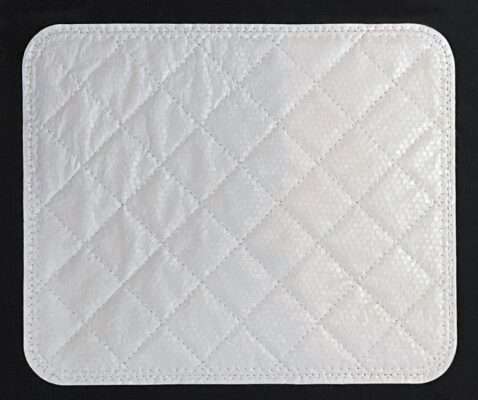
Mesh is used for reinforcement of the abdominal wall during hernia repairs to increase strength and minimize the chance of the hernia coming back (recurrence). However, some surgical techniques or improperly placed meshes can cause problems such as chronic pain, infection, foreign body sensation etc. Non-mesh repairs (also known as tissue repairs) are used for treatment of small umbilical, ventral hernias or groin hernias in patients with sensitivity to mesh or those who do not desire implantation of a synthetic material. Newer absorbable materials are also available, which can lead to reinforcement of the natural tissues during the healing process and are subsequently resorbed by the body. There are 2 categories:
- Biologic meshes: they are derived from animal tissues such as skin or stomach which undergo processing to completely remove all cells components while preserving the native collagen framework. The animal collagen is subsequently degraded and replaced with human collagen. Examples include Strattice, XenMatrix, etc.
- Bioabsorbable meshes: they are made of synthetic material that is gradually absorbed by the body over time. Examples are BioA, Phasix
While routinely used in repair of hiatal hernias, resorbable materials also have selected indications in repairs of inguinal, ventral or incisional hernias. At Minnesota Hernia Center, we believe in a shared decision-making approach, in which patients can take active part in their care, and are able to freely voice their concerns and preferences regarding the materials to be implanted or not in their bodies.
Umbilical and ventral hernias
Patients with small umbilical or ventral hernias (size of the defect less than 2 cm) and BMI less than 30 kg/m2 may benefit from primary hernia repair (closure of the defect with resorbable sutures and without mesh). These operations can be performed through a small incision hidden inside the navel, which leads to an esthetically pleasing scar once the healing is complete.
Recent research proved that long-term recurrence rates after tissue repair (no mesh) of small umbilical hernias (<1 cm) was only 1.8%. Thus, patients with small umbilical hernias undergoing a suture repair have a 98.2% chance of having a successful repair.
Inguinal hernias
Although nowadays most inguinal hernias are repaired with mesh, tissue repairs (non-mesh repairs) are possible through both an open and minimally invasive surgery approach. Many open tissue repair techniques have been developed over the years and eventually fell out of favor. Some of the most notable ones are Bassini, McVay, Halsted and Shouldice. Generally, tissue repairs aim to close the hernia defect (a hole in the muscle) with sutures, thus creating increased tension in the groin, which is likely responsible for patient disability and higher recurrence rates. The Shouldice repair is the only one which stood the test of time and is still employed successfully in select centers around the World. Of note, some of the “no mesh” techniques employ the use of steel wire or Prolene permanent suture, resulting in significant retained foreign body that may even rival some available mesh products on the market.
In select cases, resorbable meshes can be used for minimally invasive hernia repair. However, once the mesh is resorbed, the hernia would come back if the hole in the muscle (hernia defect) were left alone as in the standard technique. To mitigate this, the hole can be closed with sutures (creating some tension) and then the inguinal floor reinforced with a resorbable mesh. Caution should be used, as closure of the defect has the potential of catching nerves in the sutures, leading to chronic groin pain. These repairs can be performed in patients who do not desire implantation of a synthetic (permanent) mesh.
Furthermore, other mesh alternatives exist. Some companies produce hybrid meshes. One such example is TELA Bio. Their product, Ovitex , has a permanent scaffold made of polypropylene, and a resorbable collagen component, made of sheep rumen (stomach). This mesh reduces the synthetic material burden in the groin, but still offers some means of permanent reinforcement once the collagen is resorbed. The procedure has been popularized as the ReBAR (Reinforced Biologic Augmented Repair) Technique.
Lastly, in very few selected cases an inguinal hernia can be repaired robotically without mesh. This procedure called robotic ilio-pubic tract repair is based on an old open technique (Nyhus repair) in which the hernia defect is closed with sutures creating a tension repair. It does not represent the standard of care for inguinal hernia treatment but can be performed in thin patients with small defects. Long-term data regarding its efficacy is lacking. A single case series of 13 patients has been published to date showing promising results.
Incisional hernias
Most incisional hernia repairs require implantation of a permanent synthetic mesh in robotic, laparoscopic or open fashion. However, certain circumstances may warrant the use of a resorbable mesh. These include symptomatic hernias in women desiring future pregnancies, patients with possible returns to the OR in the future for other pathology such as inflammatory bowel disease, or patients who are opposed to implantation of a synthetic mesh. Although historically resorbable materials had decreased strength when compared with traditional polypropylene or polyester meshes, newer long-term resorbable meshes are emerging, showing comparable strength to synthetics in the initial years after repair. The operative technique and materials used are individualized based on patient’s characteristics and associated medical problems, size of hernia defect, and goals for the repair.
Hiatal hernias
Hiatal hernia repair involves partial closure with sutures of the esophageal hiatus, a natural opening in the diaphragm, the muscle that separates the chest and abdominal cavities. The goal of the repair is for the opening to only accommodate the size of the esophagus, and prevent future displacement of the stomach from the abdominal to the chest cavity. When the defect is large, the closure can lead to a certain amount of tension, which may predispose to hiatal hernia recurrence. To mitigate this, resorbable meshes are used in certain cases to buttress the closure in the initial months after repair and prevent early recurrence of the hernia. The mesh is resorbed by the body after a few months and replaced with human collagen, as seen in this video taken 1 year after the original repair.
